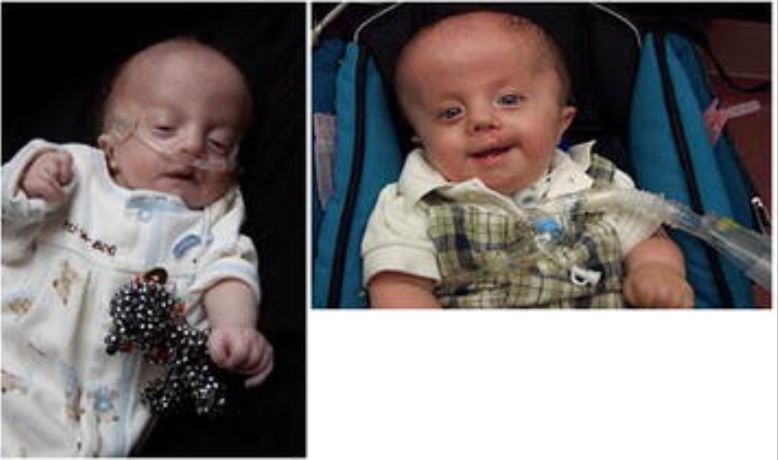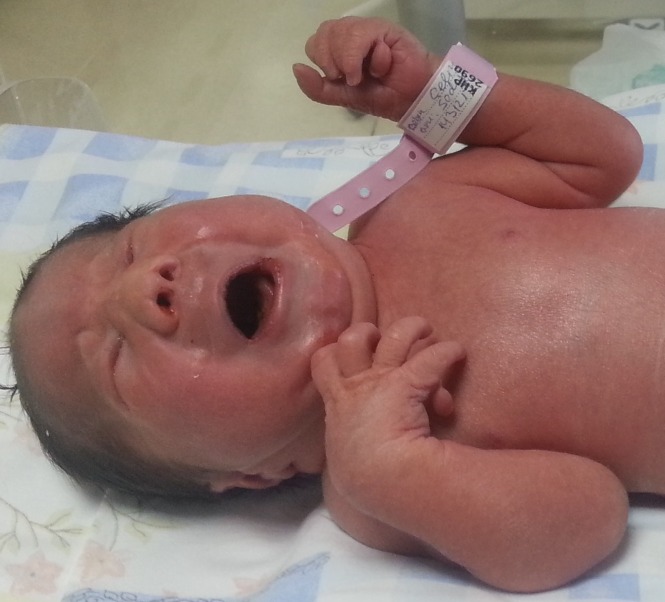Playlist
Show Playlist
Hide Playlist
Trisomy 18 and Trisomy 13
-
Slides Trisomy18andTrisomy13 Pediatrics.pdf
-
Download Lecture Overview
00:01 In this lecture, I will discuss Trisomy 18 and Trisomy 13. 00:06 For Trisomy 21, you can see one of the other lectures. 00:09 So, here?s a great way to remember. 00:12 These are also called Edwards and Patau Syndrome and just as a mnemonic, at 13 you enter puberty, so Trisomy 13 P-Puberty, P-Patau. 00:23 At 18, you can vote in an election, so 18 E-Edwards. That?s a way to remember. 00:31 Okay, let?s start with Edwards Syndrome or Trisomy 18. 00:35 This is due to 3 copies of chromosome 18 in the cells of the body. 00:41 It?s associated with characteristic dysmorphic features, which we?ll go through, severe intellectual disability, congenital malformations and a greatly reduced life expectancy. 00:52 Half of these patients will die within the first week and most within the first year. 00:57 This affects about 1 in 8,000 live births. 01:01 It?s less common than Trisomy 21 but more common than Trisomy 13. 01:07 It affects females more than males and 95% of these fetuses are spontaneously aborted. 01:14 How does this happen? More than 90% of the time, it?s a freak meiotic nondisjunction of the maternal chromosomes. 01:23 Essentially one egg has an extra gene, an extra chromosome in it and then the sperm goes and fertilizes that egg and then the patient has 3. 01:34 This risk increases with advanced maternal age, just like Down syndrome. 01:38 A small percentage of the time, this can be a result of a Robertsonian translocation. 01:44 For more on Robertsonian translocations, please review the Trisomy 21 lecture. 01:49 But generally, the idea is that the translocated spouse has 6 potential gametes that may arise and they may either have a normal child, a balanced carrier or a patient with the Trisomy 18. 02:06 The other eggs are not viable. 02:10 So the options are you have a normal child, a balanced carrier child or Trisomy 18 child. 02:18 What does Trisomy 18 look like? They have low birth weight. 02:23 They may have a prominent occiput like you can see in this patient here. 02:27 One of the key findings is micrognathia. 02:30 These children have very small jaws and it may lead to an upper respiratory distress. 02:36 They can have microcephaly despite the prominent occiput and you?ll see they have low set and malformed ears. 02:43 These infants often have clenched overlapping fingers like you can see in this picture. 02:50 That?s often will show up in our test, clenched, overlapping fingers are consistent with Trisomy 18. 02:55 Another one that shows up on the test is what we call ?Rocker-bottom? feet. 02:59 This is feet that are round on the bottom as if the patient were standing up, they could rock. 03:04 These patients will have severe intellectual disability. 03:08 They will have digestive tract abnormalities of a variety of types and they often have either cardiac or renal malformations. 03:16 The most common cardiac defect is the VSD or the ventricular septal defect. 03:21 So what are the therapies we can provide to these children? Well generally, the therapy relates to the defect that is in play. 03:31 So patients most commonly die of cardiopulmonary arrest. 03:36 They simply aren?t capable of maintaining their respiratory and cardiac effort. 03:41 This is common and remember half of these patients will die on their first week of life. 03:47 What?s key to provide to some these families is simply an acceptance that this infant is really not going to be viable. 03:54 We have to provide hospice so infants can die comfortably and we have to provide grief counseling for parents. 04:02 It?s important provide them with support group services and it?s also important to do parental chromosome studies. 04:10 The reason is if this a Robertsonian translocation, there is an increased risk substantially of future children also having this problem and they may want to do pre-selection of eggs in the future. 04:24 Let?s switch gears now to Trisomy 13 which is Patau Syndrome. 04:29 This is due to 3 copies of chromosome 13. 04:33 It results also in severe intellectual disability, multiple congenital malformations and a greatly reduced life expectancy. This affects 1 in 9500 births. 04:45 It happens in females more than males and about 60% of these fetuses will spontaneously abort in the second trimester. 04:53 What are the features? As you can see here, these patients may have holoproesencephaly. 04:59 They can develop scalp defects. 05:02 They may have very small eyes or microphthalmia. 05:05 They can develop a severe cleft lip and palate. 05:09 They often have polydactyly which is an extra finger or digit. 05:13 They may have severe cardiac or renal malformations. 05:17 There?s a lot of similarities between Trisomy 13 and Trisomy 18. 05:21 These children really don?t do very well. 05:25 The average of survival is 7-10 days and so again, family support and counseling is very important and once again chromosomal studies of the parents are indicated. 05:38 If they have a Robertsonian translocation, we need to counsel them about the risk to future infants. 05:44 So that?s my review of Trisomy?s 18 and 13. 05:49 Thanks for your attention.
About the Lecture
The lecture Trisomy 18 and Trisomy 13 by Brian Alverson, MD is from the course Pediatric Genetics. It contains the following chapters:
- Trisomy 18 (Edwards Syndrome)
- Trisomy 13 (Patau Syndrome)
Included Quiz Questions
Which of the following is a finding in Edwards syndrome?
- Rocker bottom feet
- Polydactyly
- Death in the second year of life
- Mild cognitive disability
- Macrocephaly
Which of the following chromosomal abnormalities is most often the cause of Edwards syndrome?
- Trisomy 18
- Trisomy 21
- Trisomy 13
- Trisomy 9
- Trisomy 8
Which of the following is not true regarding Edwards syndrome?
- Most commonly due to a Robertsonian translocation
- Severe intellectual disability
- Presence of significant congenital malformations
- Greatly reduced life expectancy
- More common in females than males
Which of the following is the most common type of trisomy after Down syndrome?
- Trisomy 18
- Trisomy 13
- Trisomy 9
- Trisomy 8
Patau syndrome is characterized, amongst others, by small eyes, cleft lip and palate, and polydactyly. Which of the following is not true regarding this syndrome?
- Congenital hydrocephalus is common.
- Patients can have scalp defects.
- Life expectancy is 7 to 10 days.
- Patients can have cardiac and renal malformations.
- It is due to trisomy 13.
Customer reviews
5,0 of 5 stars
| 5 Stars |
|
5 |
| 4 Stars |
|
0 |
| 3 Stars |
|
0 |
| 2 Stars |
|
0 |
| 1 Star |
|
0 |





